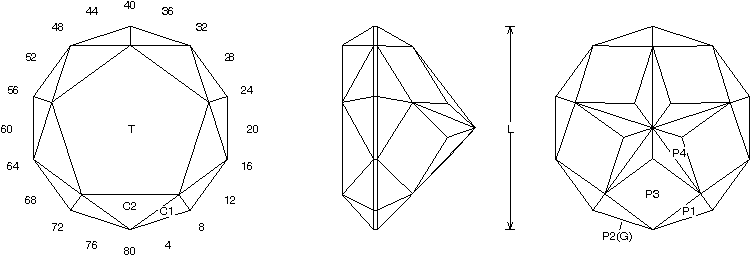Online Faceting Designs & Diagrams: Gram Lone Star
Information and guide on Faceting Designs. An Online Faceting Design Diagram by Jeff R. Graham that presents various cuts, this is called "Gram Lone Star".
3 Minute Read
Gram Lone Star by Jeff R. Graham
Merry Christmas and Happy New Year
Design 2004/2005 (for all of my customers)
"Gram Lone Star" - Cutting Remarks
Cut this in refractive indexes 1.54 to 2.14 with no changes. This design is ideal for medium to lightly saturated rough and should be cut 8mm or larger, so the star has a chance to show.
This design is new and created by me, I call it the "Gram Lone Star" to make sure people know it is my updated version of the original. I also thought a star stone was appropriate for Christmas, so here you go guys.
This design was inspired by the original Lone Star cut done by J.W. Carrol which was published in one of Mr. Vargas's original books.So while my design is new, and designed to work quite differently than the original Lone Star. The star idea (and basic design concept) was originally Mr. Carrol's. Credit where credit is due.
Note: There are several other published versions of "Lone Star" type cuts done by different people in the original Vargas books as well some other publications. All the old designs are made to work like Carrol's original, they are just variations.
The "Gram Lone Star" is designed to work in exactly the opposite way of Carrol's design (and all the others I have see). In Carrol's design the star facets P4 (in my design, his design is significantly different and has more facets so they are not the same, but the P4 tier is similar) are the only ones designed to reflect light. All the surrounding facets are designed to pass light and not reflect.
In the "Gram Lone Star" all the facets reflect light and you can see the star pattern in the reflection (look at the ray trace at the bottom of this page). No tiers or facets will drop out. This makes a much brighter finished stone and to me a more interesting cut. I worked quite a while to get the angle and tier relationships correct so the the star reflection would appear.
If you compare my design to the other Lone Star cuts (Carrol's and others) you will notice that my design is quite a bit shallower and does not use angles nearly as steep. The "Gram Lone Star" because of it's more conventional angles will work in a wider range of rough and is a bit easier to cut.
This design can be cut in different and quite interesting variations. Here are the three variations I find work the best.
Variation #1 - Cut the polished star P4 facets 2 degrees below the critical angle of your material. This causes the star to drop out and be surrounded by reflecting facets. But the polished P4 star will sparkle at you when the stone moves. An interesting effect.
Random - Cosine - ISO
Variation #2 - Frost the P4 star facets.
Variation #3 - Frost the P3 facets and polish the P4.
Note: 2 degrees below critical angle and frosted P4's makes a very sharp star. You can of course just frost the star at the regular cutting angle too. It makes a good star, just not quite as sharp, a little more subtle.
There are more polish and frost variations depending one what you want to do. But these three variations work well.
Enjoy cutting your "Gram Lone Star"… Drop me an e-mail to let me know your results and what you've cut, or feel free to inquire if you have any questions or need some help regarding this design.
Random - Cosine - ISO
Detailed faceting instructions by Jeff Graham available at The Rock Peddler
Jeff R. Graham
The late Jeff Graham was a prolific faceter, creator of many original faceting designs, and the author of several highly-regarded instructional faceting books such as Gram Faceting Designs.
Related Articles
Tut’s Crystal Glitter: Faceting Design Diagram
8-12 Star: Faceting Design Diagram
Topaz Crystal I: Faceting Design Diagram
Thor’s 1.225: Faceting Design Diagram
Latest Articles
800 Years of Mogok: A Celebration in Tenuous Times
What is the Average Gemstone Faceting Yield?
Pyroxmangite Value, Price, and Jewelry Information
How to Identify Emerald Simulants and Synthetics
Never Stop Learning
When you join the IGS community, you get trusted diamond & gemstone information when you need it.
Get Gemology Insights
Get started with the International Gem Society’s free guide to gemstone identification. Join our weekly newsletter & get a free copy of the Gem ID Checklist!
